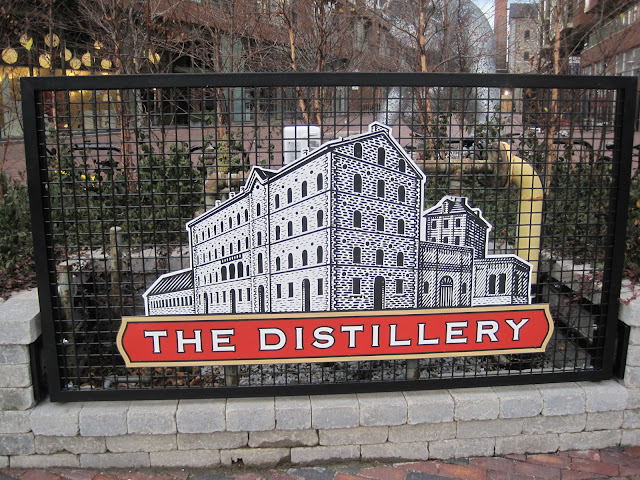So what happens when a group of developers employ about 400 workers for a year and a half to restore 47 derelict buildings that once housed the world's largest distillery? One of the country's premier hotbeds for arts and culture is born, that's what.
Hiding in the south-east corner of downtown Toronto, the 13 acre Distillery District is comprised of the largest group of Victorian industrial architecture on the continent. In 1988, it was named a National Historic Site and in 1990, after 153 straight years of production, The Distillery finally closed its doors. About a decade later the transformation occurred, and now the old Gooderham and Worts Distillery is a Toronto favourite and popular tourist destination.
If it weren't for the set-up of the Toronto Christmas Market, the rusty old truck above would have been the only vehicle I saw. The Distillery District is a pedestrian-only neighbourhood and walking around, taking in the red-bricked roads and buildings will take you back to the 1800s. But as soon as you step inside one of these fascinating buildings, you're quickly reminded which century you're in.
The shops and boutiques are filled with modern goods, offering everything from designer sound systems to kitchenware. Much of what's on display is pretty fantastic-at least until you look at the price tag. Simple, yet trendy $200 shirts in stores like Lileo are the norm, making anything more than window shopping here out of reach for most of us.
The restaurants and cafes are a bit more accessible, and no less interesting. In these too, the industrial look and feel remains, but again, it's modernity that's on the menu. Included among them is the Mill Street Brew Pub, where you can sample several of their popular local beers. In the summer, with no cars to worry about, the neighbourhood seemingly morphs into one giant patio.
More than anything though, The Distillery District is about the arts. Throughout the area, you'll find several sculptures planted right in the middle of the cobblestone streets. Furthermore, there are a total of 22 art galleries and 17 performing art companies located here. For such a small area, that is very impressive. Clearly, the vision to provide a space that would inspire creativity has become reality. The Distillery District is a haven for artists and art lovers alike.
Over the past few years, high-rise condominiums have crept into the picture. As is often the case in this city, some people oppose the appearance of these glass towers. The juxtaposition of all the Victorian industrial buildings and the high-rise condos does make for a strange sight, and it's hard to argue that this doesn't take something away from The Distillery's authenticity. And yet, the architects responsible for them insist that by placing these towers on the outer edges of The Distillery District, its historical nature will actually be amplified by the contrast.
Whether you love them or hate them, these towers have helped make The Distillery not just a district, but a neighbourhood too. This marks another step in the transformation process that began less than a decade ago. In its new form, this hood is still very young. Here's to it having as long of a run as a place to live, create and enjoy as it did as the Gooderham and Worts Distillery.
(All photos taken by Matthew McEwan)
































